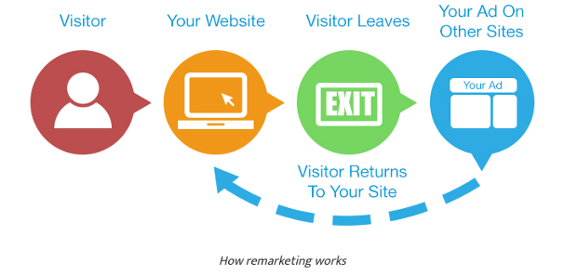Chances are, high school students surfing around the Internet, scoping out potential colleges, aren’t going to decide they want to apply to your school the first time they come across your website. They’re not going to think immediately that what you’re offering is so awesome, that it jumps to the top of their “dream schools” list, and they try to convince their parents to spend their hard-earned money paying for tuition.
But wouldn’t it be great if that happened?
When creating their marketing strategies, higher education institutions need effective ways to convert those website visits into legit leads that your admissions team can follow up with and eventually recruit. If these students visited your site, they’re obviously at least a little big interested. So you need to keep your message in front of them and convert them to an applicant.
So how can you do this and make sure more of your digital ad dollars are being well spent? The answer lies in retargeting.
The greatest reason why retargeting is one of the top marketing strategies for higher education? 95% of website visitors don’t convert on their first visit (85-90% on a landing page). Higher education marketers who use it see a higher ROI than from most other digital channels. Retargeting focuses your advertising spend on prospects who have previously visited your institution’s website. It’s an innovative way to continue to put your school in front of an already somewhat warm audience.
What is retargeting?
Retargeting, also known as remarketing, is a form of online advertising that targets your past website visitors by placing your customized ads onto other sites they later visit. So, by integrating retargeting into your higher ed marketing strategies, your school’s ads essentially will “follow” the consumer to other sites they surf. Retargeting allows you to have online reach and frequency to re-engage those bounced visitors while also keeping your school’s brand top of mind and encourage them to come back for more.
Wait, so what is remarketing?
Google Adwords launched a form of retargeting in their display network about a year ago, and they call it “remarketing,” which has caused nothing but confusion for most marketers. So remarketing is specific to the Google Adwords display network, and retargeting is the marketing approach behind remarketing.

How does retargeting work?
Retargeting tags online users by including a pixel within the target webpage or email, which sets a cookie in the user’s browser. Once the cookie is set, you, the advertiser, are able to show display ads to that user elsewhere on the internet via an ad exchange. You can anonymously ‘follow’ your targeted prospect all over the Web. This system doesn’t rely on your ability to capture data from your website visitors; rather, it requires no manual intervention or intrusive behavior on your part.
READ: Higher Education Marketing Strategies & Trends for 2017
How can your college or university benefit from this boomerang effect? Retargeting can be such a win when it comes to marketing strategies for higher education. The strategy will give you a competitive advantage by allowing you to:
- Drive prospects back to your website – Prospective students usually need to be exposed to the school program several times before deciding to submit any information to start the inquiry process. By keeping your ads in front of this audience, you’re reminding them of their interest in your school and can entice them to come back for more information. It also creates opportunities for personalized interactions with student prospects, allowing you to serve up fresh advertisements based on the prospect’s specific needs and behaviors.
- Produce leads that are easier to work through the admissions funnel – Prospects who have been retargeted are generally much easier to move through the admissions process. They have already done their research on your program and have made a calculated decision to move forward in some fashion. Through retargeting, you’ve successfully reinforced your value propositions, so when they do engage with you, they’re a much easier “sell” in moving them through the admissions funnel.
- Maximize the effectiveness of your budget dollars – So, your college has thrown a lot of money at SEO, PPC, email and social media campaigns to generate as much traffic as possible for your higher education program. You’ve spend valuable budget dollars to drive visitors to your website. All GREAT! But despite your best efforts, the vast majority of your web visitors don’t convert into a real inquiry. Guess what will help? You got it! Retargeting. Now is the time to retarget to maximize the effectiveness of those dollars already spent. By paying about a quarter of what you would normally pay per click to re-engage with past website visitors, you have a cost-effective way to generate that increase in leads.

- Re-market to past site visitors with audience-specific messaging and offers – By segmenting your prospects and using retargeting, you can hit them with the right messages at the right time, depending on where they are in the admissions funnel and which of your school’s web pages they have visited. For example, did a student fill out only the first page of an application? Did they view the financial aid page? What major did they explore on your site? The answers to these questions will allow you to send specific messaging that is likely to resonate with that prospect and pull them back to learn more, apply or ultimately, enroll in your school.
- Engage ‘stealth applicants’ by capturing prospects earlier in the college search process – Long gone are the days of having to call up the admissions office and have them mail you an information packet. With the use of today’s technology, many student prospects are able to remain “stealth applicants” – or prospects whose first recorded contact with an institution is the submission of an enrollment application. They have many ways of obtaining information from colleges without ever having to make formal contact. These applicants most likely have already had several touches with the school, but these contacts have not been captured by the marketing or admissions tracking systems. Yet with your cookie in the user’s browser, you are able to show display ads to this anonymous searcher.
READ: Trying to Recruit Students to Your College? Brand ‘the Experience’
What are some ways to retarget prospective students?
You can integrate retargeting into your college’s marketing strategy not only via Google, but on social media networks like Facebook, Twitter and Instagram. After all, that’s where your target audience is, so you have to be there too! Go where they are, speak their language, and see vast increases in interaction with your higher education ads.
Here are some of the many paths retargeting can take:
Website retargeting. This highly-effective approach involving segmenting your website visitors is the method most commonly used. By simply adding a small piece of code to different pages of your site, you can show an ad with a targeted message based on that web page’s content (the prospect’s area of interest), no matter where they travel on the web.
Customer relationship management (CRM) retargeting. This type of retargeting applies to people with whom you have established at least an initial relationship, particularly through email for student prospects and their families. This survey about online behavior of prospective college students found that nearly all respondents (high-school seniors and their parents) will open an email from a campus they are considering. Show follow-up ads to the people who have opened those emails and who have been added to your list for follow up while they are browsing the web and encourage them to come back learn more about your college or university.
FBX Retargeting. FBX stands for Facebook Exchange, the largest social network’s real-time bidding advertising platform. Similar to website retargeting, if students leave your website or are, for instance, in the process of completing an application, you can deliver follow-up display ads to them while they’re scrolling through Facebook. Similar to website retargeting, with Facebook, you can place a pixel on your website to track visits, then retarget those site visitors with the appropriate and most effective Facebook ads.
Mobile Retargeting. By 2019, mobile advertising will represent 72% of all U.S. digital ad spending, and average smartphone conversion rates are up 64% compared to the average desktop conversion rates. Bottom line: you need to integrate mobile marketing strategies into your plan, especially when cross-device retargeting is HUGE in getting people back to your site to engage. So how does retargeting work on mobile? Your website should be optimized for mobile access, ie. screen size, content length, calls to action, etc. Also, be sure to install a tracking tag on your website so you can target visitors to your website on mobile.

Video Ads. Videos can quickly show school culture, appeal to emotions and persuade students during their consideration process. You can create appealing short video ads for placement across numerous communications channels. You already have great material for the video content. Use student testimonials, teacher talks, clips of student life, or graduates talking about their career success, just for starters. Even after students get acceptance letters, encourage them with videos of your school. If you’re posting the video to Facebook, you can retarget video viewers based on the number of seconds they watched of the video, among other factors. This ability is GOLD for your ROI.
How effective is retargeting for higher education institutions?
When done correctly, retargeting can be a boon for your higher education marketing strategy. With retargeting campaigns, because you’re reaching people who have already shown a prior interest in your program (a “warm” audience), the retargeting ads get clicked on 200-400% more often than traditional online ads.
Additionally, some higher education institutions have experienced 20 to 30% higher conversion rateswith retargeting than rates they’ve seen of first-time prospects. In a nutshell: retargeting gets results!
Higher Ed Retargeting Ads Best Practices
How will you get the best results from your retargeting strategy? Use these best practices”
- It’s important to disclose your use of remarketing platformsto your users, such as informing your website visitors that you are using cookies. Legal requirements for remarketing gives more help on this.
- Retargeting is most effective if you segment your visitors and tailor the retargeting ads shown to each group.
- The best performing retargeting creative has a clear call-to-action and promotes an offer.
- Be aware of different retargeting time windows. For example, people who have visited your site need to be retargeted immediately and then periodically thereafter. During heavy enrollment periods, encouraging retargeting messages should frequently be sent.
- Too much retargeting can work against you. Retargeting specialists believe that having a user see 7 to 12 of your ads in the course of a 30-day period is ideal, but seeing the same ad every time, or seeing more than that can have a negative effect.
- Personalization in remarketing messages is also important. Remarketing presents an opportunity to tailor and test outreach by level of engagement and by student to determine which messaging is the most effective.
Has your college or university had a great experience with retargeting? How? We would love to hear from you! Make branding higher education a reality for your institution. Contact us, we’d love to help!
The email EVERY education marketer needs to sign up for…
If you found value in this blog post, we think you’ll also like our monthly education marketing newsletter. They’re packed with value and will help keep you up to date with how the latest social media trends impact digital strategy for EdTech and Higher Education organizations.
This may also be helpful…
Does your social media marketing strategy need a little guidance? We’re helping organizations transform their digital marketing efforts through personalized 2 hour, 1-on-1 trainings.
These trainings include:
- Audit of your Facebook, Instagram, & Snapchat accounts
- Maximizing your social media marketing organically
- Customized strategy for running ads that convert
- Copies of presentation & notes to review on your own
- Actionable tips to start winning on social media
Learn more through the button below and see if it’s the right fit for you & your team!
GET THE DETAILS

